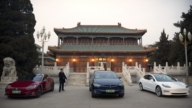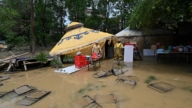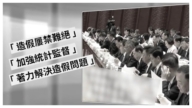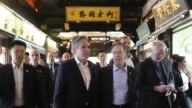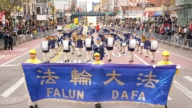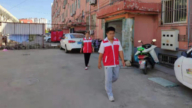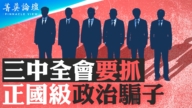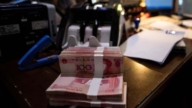【新唐人2013年08月20日讯】未来中国经济走向如何,成了时下各界关注的焦点。除了“看空中国”、“中国经济即将崩溃”等观点,近日,有消息披露,为了避免在三年后背中国经济危机的“黑锅”,中共总书记习近平和国务院总理李克强,预计会将中国年度GDP增长降落到3-4%。习李的所谓大动作能挽救中国的经济危机吗?我们来看专家的分析。
由于过去几十年不停的吹泡泡,如今中国经济已经呈现严重的“泡沫化”病态。对于刚上任的李克强,经济减速已经成为不争的现实。
第339期的《新纪元周刊》,引述一位北京消息人士独家披露,习李面临的难题是,如果继续刺激经济,则危机会在三年后出现。到那时,所有的“黑锅”都将由习李两人背上。因此他们现在的策略,是让经济在今年底或者明年初到达谷底,进入危机状态。然后通过一系列大动作改革,企图以此来“挽救经济危机”。
消息披露,基于这个考虑,习近平赞成李克强的微刺激改结构政策,使得经济先着陆,再想办法滑行起飞。内部的消息说,“李克强预计中国年度GDP增长会降落到3-4%。”
台大经济系教授张清溪:“中国经济是充满着危机,它之所以还可以不发生问题,就是政府它用行政的手段去控制各个问题。这种问题,它当然一时可以掩盖的住,但是这个事情它一直在恶化,所以终究它会出问题的。”
北京《国情内参》首席研究员巩胜利指出,中国经济目前有“三高”,包括政府、能源和企业的成本,都非常高。其中,在政府构架方面,中国是7级,而且是双重构架。这些成本都要摊到企业头上。
北京《国情内参》首席研究员巩胜利:“因为它是党政运行,从理论上讲,它比那些市场经济法治国家高出来一倍。全球的法治国家里面,党是不在所有的政府成本运行中的。而且中国(共)政府的运行,构架特别多。像美国政府,它不超过四级构架。英国、法国、德国,所有的高收入国家,它们的政府运行,都是极低的成本。”
巩胜利分析,第二大问题,就是中国社会生存和运行的成本很高,比如像水、电、煤、气,这些人们生活的基本品,成本都很高,这也让制造业成本低不下来。第三点则是,中国企业的成本高,相应的,中国企业运行的税收也是最高的。
巩胜利:“从成本论来讲,中国遇到了比较大的麻烦,特别是美国和亚太自由贸易区,还有欧美的(贸易区),今年10月底就要上路,正式运行了。如果这两个运行后,中国的成本更麻烦更麻烦。因为这两个自由贸易区最基础的点是零关税。零关税对中国(共)政府的运行是要命的呀。”
巩胜利进一步指出,中国经济危机的根源问题,非一日能解决。因为中共既要加强党的执政能力,又要减少人民和企业运行的成本,这本身就是一对矛盾体。
接近李克强智囊团的消息人士告诉《新纪元》,这次中共的北戴河会议,比以往都更难。因为讨论的是一系列的改革措施,据说还有人提出明确的反对意见。
最后这位消息人士还警告说,“如果北戴河不能获得支持,三中全会将成为习李的滑铁卢。”
8月10号,中国知名经济学家郎咸平在上海“钱荒”主题讲座上表示,中国经济正面临八大危机,包括:产能过剩、通胀、地方政府相继破产、国企危机、民企危机爆发、银行、股市、地产等。
郎咸平表示,中共当局五年投资了两个四万亿,印钞66万亿,其中国企拿了20万亿,地方政府20万亿,导致严重的通货膨胀,每年的实际通胀20%,全世界最高。
7月29号,《纽约时报》的一篇署名文章表示,“看空中国目前已成为主流观点,几乎每天都能看到一篇关于经济崩溃即将到来的报导。”
采访/刘惠 编辑/王子琦 后制/李月
The Big Move of China’s New Leaders: Drop GDP Growth
The future of China’s economy has become the focus of many.
On top of the general feeling of “bearishness toward China"
and its economy’s “impending crash,"
it was recently revealed that Chinese Communist Party (CCP)
General Secretary Xi Jinping and Premier Li Keqiang are
expected to drop China’s annual GDP growth to
between 3 and 4%,
in order to avoid taking the blame of
the upcoming economic crisis in three years.
Will Xi and Li’s big move save China from economic crisis?
The continuous economic bubble blowing in the past decades
has led China’s economy into a big bubble problem.
To the new premier Li Keqiang,
economic slowdown has become an indisputable reality.
Issue 339 of The New Epoch Weekly quoted a Beijing inside
source who revealed Xi and Li’s dilemma to the periodical.
That is, if they continue to stimulate the economy,
the crisis will occur in three years and they will take all blame.
So their strategy is to let the economy reach the bottom
at the end of this year or early next year, into a state of crisis.
Then they will have a series of big moves
in an attempt to “save the economic crisis."
The insider says that, based on this consideration, Xi agrees
with Li’s micro-stimulating and structural change policies.
The economy will first land, and then take off.
Internal sources say,
“Li Keqiang expects China’s annual GDP growth fall to 3-4%."
Zhang Qingxi, professor at National Taiwan University’s
Department of Economics: “China’s economy is full of crises.
The government uses its power to control all the issues.
They might be able to cover them up for a while,
but the issues will get worse and will eventually show."
Gong Shengli, Beijing Internal Reference chief researcher,
says the cost of China’s economy is high –
the cost of government, energy and enterprises are all high.
In terms of structure, China’s government has seven
administrative levels, and these are double structures.
These costs are all taken on by enterprises.
Gong Shengli: “The Chinese government includes the
regular governmental operations plus those of the CCP.
In theory, it costs double that of a market economy country.
In western countries, the government doesn’t bear
the expenses of political parties.
The U.S. government has a less than a four level structure.
The governments of all high income countries, such as France,
the U.K. and Germany operate on very low cost."
Gong Shengli says that the second big issue is the high cost
of living in China, such as water, electricity, coal and gas.
The costs of these basic living necessities is very high,
leading to high manufacturing costs.
The third big issue is the high cost of China’s enterprises
and which have the highest taxes.
Gong Shengli: “As for costs, China has run into big problems.
Especially with regard to the Asia Pacific Free Trade Zone and
the Europe-North America Trade Zone that starts in October.
The basis of these free trade zones is no tax.
Zero tax is a key issue to the Chinese government."
Gong Shengli further points out that the fundamental issue
of China’s economic crisis can’t be solved in a day.
For the CCP to strengthen its power
while reducing human and business costs is contradictory.
An insider who is close to Li Keqiang’s think-tank told
The New Epoch that
the CCP’s meeting in Beidaihe this year is harder than ever.
The CCP discussed a series of issues on reform.
The source said that someone raised objections.
The insider also warned that, “If Xi and Li can’t get support
at the Beidaihe meeting,
they will end up in failure at the CCP’s Third Plenary Session."
On August 10, China’s well-known economist, Lang Xianping,
said during his lecture on the “Money Shortage" in Shanghai,
China’s economy is facing eight major crises: inflation,
over-capacity of production, bankrupt local governments,
state-owned enterprises crises, private enterprises crises,
bank, stock market and real estate, etc.
Lang says the CCP authorities invested four trillion yuan
($653 trillion) twice and printed 66 trillion yuan ($10.7 trillion) in the past five years.
Both state-owned enterprises and local governments
got 20 trillion yuan ($3.26 trillion),
leading to serious inflation of 20% each year,
the world’s highest.
On July 29, an article on New York Times reported,
“Bearishness toward China has now gone mainstream,
and rare is the day without a report on the economy’s
impending crash."


